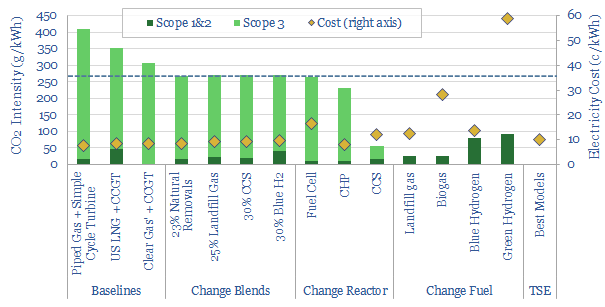The EU green taxonomy is a set of guidelines that label some investments as ‘green’. Its purpose, the European Commission states is to “help investors identify economic activities in line with our environmental and climate objectives”.
Under new rules in February-2022, natural gas will be considered green if it clearly replaces higher-carbon fuels (coal) and has a CO2 emissions limit below 270g of CO2 per kWh (and meets other byzantine requirements).
Our goal in this data-file is to avoid politics, and simply present some numbers, for what it would take to reach 270g/kWh CO2 intensity across different fuels.
Our first conclusion is that most conventional gas projects will not meet this hurdle, even if they use highly efficient CCGTs and burn ‘clear gas’ where all the Scope 1&2 CO2 emissions have been offset by producers.
What is most likely to accelerate based on the EU green taxonomy is the use of CHPs, and possibly also some fuel cells, which can achieve higher efficiencies and thus attain 200-270g/kWh CO2 intensities.
Also potentially helped are blends of conventional gas plus landfill gas (c25%), nature-based CO2 removals (20-25%), blue hydrogen (30%) and CCS (c33%). Generally these blends do not look too bad on costs, inflating a marginal cost around 8c/kWh for conventional gas power to around 9-10c/kWh.
